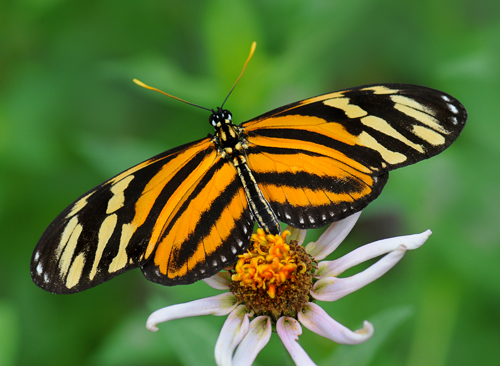
Lycorea halia (Lycorea halia)
Phylum — arthropoda
Class — insecta
Order — lepidoptera
Family — nymphalidae
Genus – lycorea
Appearance
The fully-grown larvae are white, with narrow black rings around each segment. They have a pair of motile black filaments behind the head, which probably serve to ward off parasitoids. The wingspan is about 95–108 mm. The wings are orange with horizontal black stripes and black edging. The tips of the forewings are black with yellow spots. The black border of the hindwings is dotted with small white spots.
Habitat
Lycorea halia is a widespread species found from Mexico to Peru, and on most of the larger islands of the Caribbean.
Behavior
Both sexes spend most of their lives in the sub-canopy but can also occasionally be found at rest on the foliage of saplings in light gaps. Flight – in April, July, and October in South Texas; all year - in the tropics.
It demonstrates daily activity. Butterflies are poisonous. The poison accumulates from the plants that the caterpillars feed on. Young larvae nibble rings into the leaf tissue to cut off the plants defensive toxins before eating the area enclosed within the ring. Older larvae bite through the veins of leaves causing the toxins to bleed out before eating them.
Diet
Adults feed on bird droppings. The larvae feed on Carica papaya, Ficus carica, Asclepias curassavica and Jacaratia.
Reproduction
For their reproduction you need a mash cage with a size of 50 x 50 x 70 cm. The eggs are white. They are laid singly on the underside of leaves of the foodplants which include Carica, Jacaratia (Caricaceae), Ficus (Moraceae) and Asclepias (Asclepiadaceae). It is better to keep the caterpillars in mesh cages; each cage should have 6-8 caterpillars. You need to place a branch of the forage plant in the cage. Forage plants should be replaced every 3-4 days. The keeper should maintain the temperature of 22-25 o C and the level of the humidity 65-70%. The chrysalis is pale green and barrel shaped with compressed abdominal segments. It is formed hanging from a leaf or stem of the foodplant.
In captivity
The mesh terrarium with a size of 50 × 50 × 70 mm is suitable for keeping butterflies. Room temperature is necessary. Daylight time is 12 hours. You can feed the butterflies with an overripe banana or give them a syrup of honey diluted with boiled water in a ratio of 1:10.
 Russian
Russian
 English
English























